Related Research Articles

The Glyn Valley Tramway was a narrow gauge railway that ran through the Ceiriog Valley in north-east Wales, connecting Chirk with Glyn Ceiriog in Denbighshire. The gauge of the line was 2 ft 4 1⁄2 in. The total length of the line was 8 1⁄4 miles (13.3 km), 6 1⁄2 miles (10.5 km) of which were worked by passenger trains, the remainder serving a large granite quarry and several minor slate quarries.
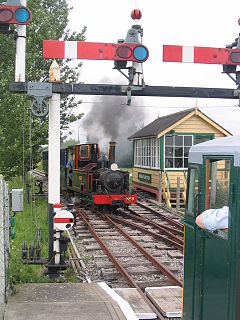
The Gartell Light Railway is a privately run narrow gauge railway located at Yenston in the Blackmore Vale, south of Templecombe, in Somerset, England. It operates a 2 ft narrow gauge railway running for 3⁄4 mile (1.2 km), partly along the track of the old Somerset and Dorset Joint Railway. The railway has 4 stations - Common Lane, Pinesway Junction, Park Lane and Tower View.

The West Lancashire Light Railway (WLLR) is a 2 ft narrow gauge railway that operates at Hesketh Bank, situated between Preston and Southport in North West England. The distance between the stations on the railway is 430 yards (393 m), though track extends eastwards beyond Delph station on ledge above the old clay pit which is too narrow to contain a run round loop. An extension of up to 435 metres (1,427 ft), running along the north bank of the fishing lake has been proposed. The railway has eight steam locomotives, four of which are in operating condition; one is currently being restored and another is on static display. There are also two electric locomotives and many IC locomotives.

The Bala Lake Railway is a narrow-gauge railway along the southern shore of Bala Lake in Gwynedd, North Wales. The line, which is 4 1⁄2 miles (7.2 km) long, is built on a section of the former standard-gauge Ruabon–Barmouth GWR route that closed in 1965. Another section of the former permanent way is used by the Llangollen Railway. The Bala Lake Railway, which runs on 1 ft 11 5/8 in (600mm)-gauge preserved rolling stock, is a member of the Great Little Trains of Wales.
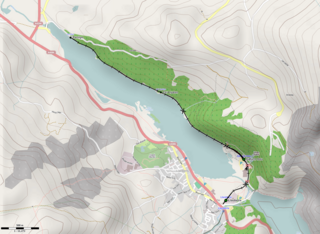
The Llanberis Lake Railway is a 1 ft 11 1⁄2 in narrow gauge heritage railway that runs for 2.5 miles (4 km) along the northern shore of Llyn Padarn in north Wales in the Snowdonia National Park. The starting point is the town of Llanberis at the eastern end of the lake, with the western terminus at Pen Llyn in the Padarn Country Park. The return journey takes around 60 minutes.

The Penrhyn Quarry Railway first opened in 1798 as the Llandegai Tramway; it became the Penrhyn Railway in 1801 although on a different route. Constructed to transport slate from Lord Penrhyn's slate quarries at Bethesda to Port Penrhyn at Bangor, Wales, the railway was around six miles (9.7 km) long and used a gauge of 1 ft 10 3⁄4 in. The line was one of the earliest narrow gauge railways in the world. It closed on 24 July 1962, being lifted in 1965 when the track was sold to the Ffestiniog Railway.

There were more than a thousand British narrow-gauge railways ranging from large, historically significant common carriers to small, short-lived industrial railways. Many notable events in British railway history happened on narrow-gauge railways including the first use of steam locomotives, the first public railway and the first preserved railway.

The Great Whipsnade Railway, also known as The Jumbo Express, is an English, 2 ft 6 in narrow gauge heritage railway that operates within ZSL Whipsnade Zoo in Bedfordshire, England.
British industrial narrow-gauge railways are narrow-gauge railways in the United Kingdom and the Isle of Man that were primarily built to serve one or more industries. Some offered passenger services for employees or workmen, but they did not run public passenger trains. They are categorized by the primary industry they served.

The Cadeby Light Railway was a 2 ft narrow-gauge railway in the garden of the rectory in Cadeby, Leicestershire.
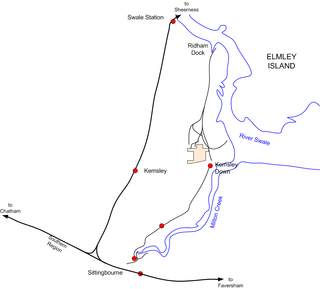
The Bowaters Paper Railway was a 2 ft 6 in narrow gauge industrial railway. It had the distinction of being the last steam-operated industrial narrow gauge railway in Britain when it closed in 1969. Part of the system still operates as the Sittingbourne & Kemsley Light Railway.
The Knebworth and Winter Green Railway was a 1 ft 11 1⁄2 in narrow gauge railway built in the grounds of Knebworth House in 1972 as a tourist attraction.
James Ian Craig Boyd was an English author and narrow-gauge railway historian.

The Leighton Buzzard Light Railway (LBLR) is a light railway in Leighton Buzzard in Bedfordshire, England. It operates on 2 ft narrow-gauge track and is just under 3 miles (4.8 km) long. The line was built after the First World War to serve sand quarries north of the town. In the late 1960s the quarries switched to road transport and the railway was taken over by volunteers, who now run the line as a heritage railway.
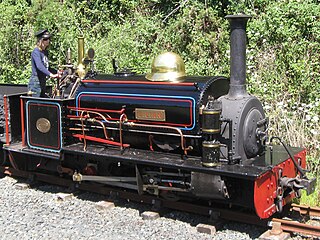
The Penrhyn Port Class was a class of three narrow gauge steam locomotives built for the Penrhyn Quarry Railway (PQR). These locomotives were built by the Hunslet Engine Company between 1883 and 1885 and supplied specifically to work at Port Penrhyn near Bangor, north Wales. They were a variant of the standard Dinorwic Alice Class design.
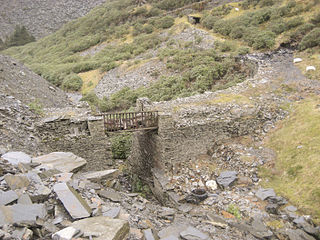
Some industrial narrow-gauge railways in the United Kingdom and the Isle of Man were primarily built to serve quarrying, mining, and similar industries. Some of these narrow-gauge railways offered passenger services for employees or workmen, but they did not run public passenger trains. They are listed by the primary industry they served.

Edward Thomas is a narrow gauge steam locomotive. Built by Kerr Stuart & Co. Ltd. at the California Works, Stoke-on-Trent in 1921, it was delivered new to the Corris Railway where it ran until 1948. After that railway closed, the locomotive was brought to the Talyllyn Railway in 1951, then restored, and remains in working order at the heritage railway. It has carried the operating number 4 under four successive owners.

The Dinorwic Alice Class is a class of eleven narrow gauge steam locomotives built specifically for the Dinorwic Slate Quarry. These locomotives were built by the Hunslet Engine Company between 1886 & 1904 & were designed & supplied specifically to work the many galleries of the Dinorwic Slate Quarry at Llanberis, North Wales.

Holy War is a preserved narrow gauge steam locomotive built in 1902, based at the Bala Lake Railway in North Wales. It was the last steam locomotive to operate in a Welsh slate quarry.

Maid Marian is a preserved narrow-gauge steam locomotive built in 1903, currently based at the Bala Lake Railway in North Wales.
References
- ↑ "Railway author sues". 457. Steam Railway. September 2016.
- ↑ Thomas, Cliff (March 1998). "The Bala Lake Railway". Railway World Magazine.
- 1 2 Cliff Thomas: A nationally known writer and reporter of the heritage steam and railway scene in Britain and Ireland. Rail.co.uk.
- ↑ "World War 1 railway veteran needs YOUR help to complete its overhaul". 6 October 2015.
- ↑ Hughes, Owen (24 November 2016). "Copyright row over children's book about a Bala steam engine called Alice". Daily Post.